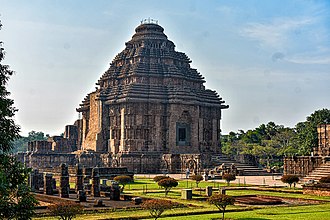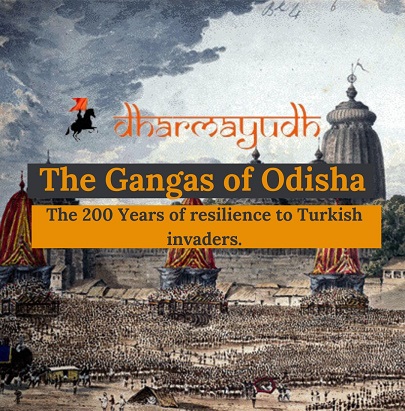The land of Kalinga had produced valiant kings who had guarded the land of Trikalinga for centuries. They had proved to be tough fighters to their adversaries which regularly eyed on their throne.
The kings like Maharaja Kharavela established their supremacy over the region and even marched against Magadha and decimated its hordes which once invaded their country during Ashoka’s reign.

The resilience displayed by the Orissa and their kings to shield the freedom of their country from the onslaught of invaders remained unmatched throughout Indian history.
In this article, we will cover the heroic story of a kingdom that once resided in the land of Orissa and was known for its spirited resistance which kept the Turkish hordes at bay.
The kings of this dynasty constructed famous temples like Jagannath Puri and Konark temple and a great patron of art and culture which to this day can be regarded as the identity and heritage of Odisha.
The Turkish hordes ravaged northern India around the end of the 12th century CE and reached as far as Bengal and central India. But the audacious resilience displayed by this dynasty defied the Turkish invaders for centuries when most of the Hindu kingdoms were absorbed by the latter.
So who were these people which despite being offering heroic resistance to the foreign invaders couldn’t find mention in our historical books?
This unheard dynasty of Odisha is none other than the Gangas which probably emerged supreme around 11th CE however their former kings ruled the smaller regions from 9th CE.
Content
Kalinga After Maharaja Kharavela
In our previous article, we delved into the history of Maharaja Kharavela in detail. Moving on after the rule of Kharavela several different dynasties took possession of Kalinga.
There were also times when the neighboring kingdoms established their hegemony over Odisha. For example, there times when Guptas, Maharaja Sasanka of Bengal, and Harshvardhana made the region as there vassals.
Later around 7th CE i.e. probably after the downfall of the Harsha’s empire the Sailodbhavas emerged as the ruler of the Kalinga region.
After them came the center of theme of this article i.e. the Gangas.
Rise of the Gangas of Odisha
The Gangas (Eastern Gangas) emerged around the late 9th CE under their king, Indravarman. Many suggest that there might be some sort of relation between the Gangas of Odisha and the dynasty which ruled with a similar name at Mysore.
However, nothing can be said with surety.
These early Gangas made Dantapura their capital and their rulers even assumed the titles of Lord of the Kalinga and Lord of the Trikalinga which signifies their prowess.
The early Gangas ruled for about 4 centuries and after them came the Later Gangas which in history are known for their heroism and cultural significance.
Later Gangas and their Staunch Defence Against the Turks
With the decline of the early Gangas around 11th CE another dynasty emerged as a paramount power in Odisha and was called the Later Gangas.
There first king who is referred as Vajrahasta-Anantavarman probably ascended the throne around 1030 CE at the time when the northern portion of the subcontinent was witnessing the onslaughts of the Ghaznavid Turks.
King Vajrahasta assumed honorary titles like Trikalingadhipati and even issued a large number of inscriptions of his name from his capital Kalinganagara.
He was succeeded by his son Anantavarman-Chodaganga who is regarded as the real founder of this dynasty. King Anantavarman’s kingdom was surrounded by many adversaries of that period in Cholas were the prominent ones.
Anantavarman was able to protect his empire from his adversaries and even extended his territories by reaching Bengal.
He is credited with having constructed the famous Jagannath at Puri around the 12th century and is also mentioned in the famous Kendupatna copper plate inscription of his successor Narsimhadeva II.

To this day the sacred temple of Jagannath Puri remains a symbol of religious and cultural patriotism of the Gangas.
Anantavarman conquered the territories as far as Hoogly in Bengal but his successor couldn’t hold their region probably due to the incursions led by neighboring kingdoms and Turks.
Later Bakhtiyar Khilji invaded Bengal defeated its Sena ruler Lakshmana Sena and advanced up to the border region of Orissa.
This was a signal of the upcoming storm for Odisha and its people as the Turks had made themselves the master of the territories lying between Sindh to Bengal and from Punjab to Malwa.
Kingdoms after kingdom of India fell in front of Muhammad Ghori and his Turkish Slave dynasty they now have eyes on the territories ruled by the Gangas.
However, the Gangas proved to be the toughest fighter of the Indian subcontinent.
The successors of Maharaja Anantavarman thoroughly checked the invasion led by the Turks. In the year 1205 CE Rajaraja III the grandson of King Anantavarman Chodaganga defeated the Turkish army sent by Bakhtiyar Khilji and killed its commander.
After Rajaraja III his son who succeeded him maintained the hegemony of the Gangas over Odisha despite being surrounded by enemies from all sides.
Anangabhima III who ruled from 1216-1235 the son of Rajaraja III valiantly fought against the Sultans of Bengal, the Kalachuris of Tummana, and the Kakatiyas of Warangal.
He defeated all three powers and remained independent throughout his reign.
Narasimha I the successor of Anangabhima was probably the most aggressive ruler of the Ganga dynasty. He defeated the Bengal sultan in 1243 and defeated its general at a region referred to as Katasin and annexed Lakhnor. But he didn’t stop there and fought four more battles against the Turkish rulers of Bengal and defeated them in three key battles.

In the fourth war against the Bengal sultan, Narasimha I faced defeat, and the Gangas lost some of their territories to the Bengal. Apart from his military achievements Narasimha I is credited to have constructed the famous Konark temple near Puri.
Narasimha II succeded his father and he conquered the lost territories of the Gangas from the Bengal Sultanate in the year 1296 and issued grants.
Ulugh Khan after annexing the Warrangal kingdom attacked Gangas but faced defeat in 1323 at the hands of King Bhanudeva II the son and successor of Narasimha II.
Furthermore, Narasimha IV who ruled from 1379-1424 faced several incursions from the neighboring sultanates like Deccan, Jaunpur, and Malwa.
However, despite the loss of strength, resources, and man power which weakened the kingdom of the Gangas there king Narasimha IV maintained the supremacy of the Gangas over Odisha and safeguarded his kingdom from barbaric invaders.
The Gangas of Odhish and there forgotten kings remained a staunch symbol of Hindu resilience against the Turkish adversaries.
When most of the sub-continent crumbled against the Turks the Gangas maintained the freedom of their kingdom for more than 200 years.
The famous historian R.C. Majumdar in his book Ancient India mentioned the bravery of the Ganga dynasty in his own words. He writes…
The Gangas thus achieved the unique distinction of being the only Indian royal dynasty that successfully resisted the Muslim onslaught for more than two centuries and maintained their independence to the very end after the Muslims had conquered the rest of India.
LIKE WHAT WE ARE DOING? DONATE TO DHARMAYUDH
If you support what we are doing and would like to contribute to help us grow and reach more Indians to teach them more about such forgotten historic Indian Heroes and stories, please consider donating any amount. It will help us grow.

